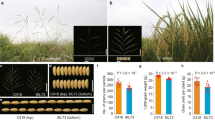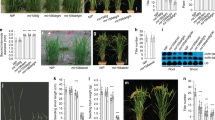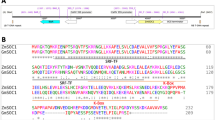Abstract
Increasing grain yields is a major focus of crop breeders around the world. Here we report that overexpression of the rice microRNA (miRNA) OsmiR397, which is naturally highly expressed in young panicles and grains, enlarges grain size and promotes panicle branching, leading to an increase in overall grain yield of up to 25% in a field trial. To our knowledge, no previous report has shown a positive regulatory role of miRNA in the control of plant seed size and grain yield. We determined that OsmiR397 increases grain yield by downregulating its target, OsLAC, whose product is a laccase-like protein that we found to be involved in the sensitivity of plants to brassinosteroids. As miR397 is highly conserved across different species, our results suggest that manipulating miR397 may be useful for increasing grain yield not only in rice but also in other cereal crops.
This is a preview of subscription content, access via your institution
Access options
Subscribe to this journal
Receive 12 print issues and online access
$209.00 per year
only $17.42 per issue
Buy this article
- Purchase on Springer Link
- Instant access to full article PDF
Prices may be subject to local taxes which are calculated during checkout



Similar content being viewed by others
References
Xing, Y. & Zhang, Q. Genetic and molecular bases of rice yield. Annu. Rev. Plant Biol. 61, 421–442 (2010).
Song, X.J., Huang, W., Shi, M., Zhu, M.Z. & Lin, H.X.A. QTL for rice grain width and weight encodes a previously unknown RING-type E3 ubiquitin ligase. Nat. Genet. 39, 623–630 (2007).
Mao, H. et al. Linking differential domain functions of the GS3 protein to natural variation of grain size in rice. Proc. Natl. Acad. Sci. USA 107, 19579–19584 (2010).
Xue, W. et al. Natural variation in Ghd7 is an important regulator of heading date and yield potential in rice. Nat. Genet. 40, 761–767 (2008).
Sakamoto, T. et al. Genetic manipulation of gibberellin metabolism in transgenic rice. Nat. Biotechnol. 21, 909–913 (2003).
Hong, Z. et al. A rice brassinosteroid-deficient mutant, ebisu dwarf (d2), is caused by a loss of function of a new member of cytochrome P450. Plant Cell 15, 2900–2910 (2003).
Tanabe, S. et al. A novel cytochrome P450 is implicated in brassinosteroid biosynthesis via the characterization of a rice dwarf mutant, dwarf11, with reduced seed length. Plant Cell 17, 776–790 (2005).
Sakamoto, T. et al. Erect leaves caused by brassinosteroid deficiency increase biomass production and grain yield in rice. Nat. Biotechnol. 24, 105–109 (2006).
Bartel, D.P. MicroRNAs: genomics, biogenesis, mechanism, and function. Cell 116, 281–297 (2004).
Miura, K. et al. OsSPL14 promotes panicle branching and higher grain productivity in rice. Nat. Genet. 42, 545–549 (2010).
Jiao, Y. et al. Regulation of OsSPL14 by OsmiR156 defines ideal plant architecture in rice. Nat. Genet. 42, 541–544 (2010).
Zhu, Q.H. et al. A diverse set of microRNAs and microRNA-like small RNAs in developing rice grains. Genome Res. 18, 1456–1465 (2008).
Xue, L.J., Zhang, J.J. & Xue, H.W. Characterization and expression profiles of miRNAs in rice seeds. Nucleic Acids Res. 37, 916–930 (2009).
Chen, C.J. et al. Genome-wide discovery and analysis of microRNAs and other small RNAs from rice embryogenic callus. RNA Biol. 8, 538–547 (2011).
Ikeda-Kawakatsu, K. et al. Expression level of ABERRANT PANICLE ORGANIZATION1 determines rice inflorescence form through control of cell proliferation in the meristem. Plant Physiol. 150, 736–747 (2009).
Terao, T., Nagata, K., Morino, K. & Hirose, T. A gene controlling the number of primary rachis branches also controls the vascular bundle formation and hence is responsible to increase the harvest index and grain yield in rice. Theor. Appl. Genet. 120, 875–893 (2010).
Jones-Rhoades, M.W., Bartel, D.P. & Bartel, B. MicroRNAS and their regulatory roles in plants. Annu. Rev. Plant Biol. 57, 19–53 (2006).
Jones-Rhoades, M.W. & Bartel, D.P. Computational identification of plant microRNAs and their targets, including a stress-induced miRNA. Mol. Cell 14, 787–799 (2004).
Jeong, D.H. et al. Massive analysis of rice small RNAs: mechanistic implications of regulated microRNAs and variants for differential target RNA cleavage. Plant Cell 23, 4185–4207 (2011).
Riva, S. Laccases: blue enzymes for green chemistry. Trends Biotechnol. 24, 219–226 (2006).
Berthet, S. et al. Disruption of LACCASE4 and 17 results in tissue-specific alterations to lignification of Arabidopsis thaliana stems. Plant Cell 23, 1124–1137 (2011).
Yamamuro, C. et al. Loss of function of a rice brassinosteroid insensitive1 homolog prevents internode elongation and bending of the lamina joint. Plant Cell 12, 1591–1606 (2000).
Zhang, L.Y. et al. Antagonistic HLH/bHLH transcription factors mediate brassinosteroid regulation of cell elongation and plant development in rice and Arabidopsis. Plant Cell 21, 3767–3780 (2009).
Nakamura, A. et al. The role of OsBRI1 and its homologous genes, OsBRL1 and OsBRL3, in rice. Plant Physiol. 140, 580–590 (2006).
Hu, X. & Liu, Y. The construction of RNAi vectors and the use for gene silencing in rice. Mol. Plant Breed. 4, 621–626 (2006).
Toki, S. et al. Early infection of scutellum tissue with Agrobacterium allows high-speed transformation of rice. Plant J. 47, 969–976 (2006).
Wang, J.F., Zhou, H., Chen, Y.Q., Luo, Q.J. & Qu, L.H. Identification of 20 microRNAs from Oryza sativa. Nucleic Acids Res. 32, 1688–1695 (2004).
Kouchi, H. & Hata, S. Isolation and characterization of novel nodulin cDNAs representing genes expressed at early stages of soybean nodule development. Mol. Gen. Genet. 238, 106–119 (1993).
Suzaki, T. et al. The gene FLORAL ORGAN NUMBER1 regulates floral meristem size in rice and encodes a leucine-rich repeat receptor kinase orthologous to Arabidopsis CLAVATA1. Development 131, 5649–5657 (2004).
Li, R. et al. SOAP2: an improved ultrafast tool for short read alignment. Bioinformatics 25, 1966–1967 (2009).
Zhang, G. et al. Deep RNA sequencing at single base-pair resolution reveals high complexity of the rice transcriptome. Genome Res. 20, 646–654 (2010).
Xin, P., Yan, J., Fan, J., Chu, J. & Yan, C. An improved simplified high-sensitivity quantification method for determining brassinosteroids in different tissues of rice and Arabidopsis. Plant Physiol. doi: http://dx.doi.org/10.1104/pp.113.221952 (25 June 2013).
Acknowledgements
We thank Q. Qian for helping with the field trial and C.C. Chu for the comments on brassinosteroid analysis. This research was supported by a key project of the National Natural Science Foundation of China (No. U0631001 and 90917011), funds from Ph.D. Programs Foundation of Ministry of Education of China (20120171130003), and from the Natural Science and Technology Department of Guangdong Province (2009A020102001 and S2011020001232).
Author information
Authors and Affiliations
Contributions
Y.-C.Z. conceived the experiment, and together with Y.Y., C.-Y.W., Z.-Y.L. and Q.L. carried it out; J.X. and J.-Y.L. carried out the transgenic plant generation and analysis; X.-J.W. and L.-H.Q. analyzed the data; F.C. carried out the field trial; P.X., C.Y. and J.C. performed brassinosteroid detection; Y.-C.Z., H.-Q.L. and Y.-Q.C. conceived the experiment and wrote the paper.
Corresponding authors
Ethics declarations
Competing interests
The authors declare no competing financial interests.
Supplementary information
Supplementary Text and Figures
Supplementary Figures 1–5 and Supplementary Tables 1–3 (PDF 741 kb)
Rights and permissions
About this article
Cite this article
Zhang, YC., Yu, Y., Wang, CY. et al. Overexpression of microRNA OsmiR397 improves rice yield by increasing grain size and promoting panicle branching. Nat Biotechnol 31, 848–852 (2013). https://doi.org/10.1038/nbt.2646
Received:
Accepted:
Published:
Issue Date:
DOI: https://doi.org/10.1038/nbt.2646
This article is cited by
-
Identification of self- and pathogen-targeted miRNAs from resistant and susceptible Theobroma cacao variety to black pod disease
Scientific Reports (2024)
-
Cytological observation and RNA-seq analysis reveal novel miRNAs high expression associated with the pollen fertility of neo-tetraploid rice
BMC Plant Biology (2023)
-
Cytological, transcriptome and miRNome temporal landscapes decode enhancement of rice grain size
BMC Biology (2023)
-
miR397-LACs mediated cadmium stress tolerance in Arabidopsis thaliana
Plant Molecular Biology (2023)
-
Negative regulators of grain yield and mineral contents in rice: potential targets for CRISPR-Cas9-mediated genome editing
Functional & Integrative Genomics (2023)



